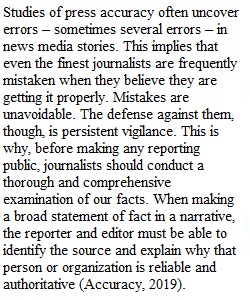


Q Defining "Facts" We have talked about what makes news "news" and what makes a journalist a "journalist." For this discussion, you will explore what makes information "fact." Remember the Jussie Smollett case? As believable as his story seemed, none of it turned out to be true. Digital technologies have revolutionized the collection and dissemination of information, making it difficult to separate fact from fiction. The problem reflects what the Center for Journalism Ethics at the University of Wisconsin-Madison says are tensions between traditional journalism, which values accuracy, pre-publication verification, impartiality, fairness, balance, and gate-keeping, and online journalism, which emphasizes immediacy, transparency, partiality, non-professional journalists and post-publication correction. Media Ethics magazine sees that tension as manifesting itself in: • Plagiarism has become an often-accepted practice and international cultural norm due at least in part to the ease and temptation of copying online sources. • Digitally altering images or video is common in advertising and sometimes in news. • Using anonymous sources is frequently an accepted practice in journalism. • Omnidirectional imaging and drones are more than science fiction. • WikiLeaks and the transparency of public records have changed how the public understands government, the military and big business around the world. • Artificial intelligence and computerized newswriting are commercial realities. • Social media, webcams and other online intrusions on privacy are part of every citizen's daily life. • Conducting interviews via technological intermediaries, such as email, has become common. Many journalists and news organizations turn to the Society of Professional Journalists' ethics code as their arbiter in thorny situations. Other organizations, such as the Reuters, Associated Press, and The New York Times, have developed their own in-house guidelines. For example, in its guidelines on integrity, The New York Times says: At a time of growing and even justified public suspicion about the impartiality, accuracy, and integrity of some journalists and some journalism, it is imperative that The Times and its staff maintain the highest possible standards to ensure that we do nothing that might erode readers' faith and confidence in our news columns. This means that staff members should be vigilant in avoiding any activity that might pose an actual or apparent conflict of interest and thus threaten the newspaper's ethical standing. And it also means that the journalism we practice daily must be beyond reproach. Meanwhile, the latest Associated Press Stylebook's rules advise: AP Stylebook? Verified account @APStylebook Jun 20 The term fake news may be used as shorthand for deliberate falsehoods masked as news circulating on the internet. #APStyleChat AP Stylebook? Verified account @APStylebook May 31 Don't label as fake news specific news items that are disputed. If fake news is used in a quote, ask for details. #APStyleChat Despite efforts, we still end up with stories like this Washington Post one about the number of Americans who think chocolate milk comes from brown cows — a poorly handled survey that became a poorly reported news story and then went viral on the internet. The Columbia Journalism Review concluded: We've become [so] accustomed to seeing these kinds of [stories and] "the media" … looking either lazy and gullible, or malicious for trying to mislead the public. … [I]f we feel like we can't trust journalists to vet the small stuff for us, we worry that we can't trust them with the big stuff, either. According to a Shorenstein Center report: There are some possible pathways for reducing fake news, including: (1) offering feedback to users that particular news may be fake (which seems to depress overall sharing from those individuals); (2) providing ideologically compatible sources that confirm that particular news is fake; (3) detecting information that is being promoted by bots and "cyborg" accounts and tuning algorithms to not respond to those manipulations; and (4) because a few sources may be the origin of most fake news, identifying those sources and reducing promotion (by the platforms) of information from those sources. Many journalists think the answer for them and news consumers may rest in crowdsourced fact-checking and content curation and annotation, using tools such as News Genius, the News Literacy Project, Harvard's five ways to spot fake news, and the Center for Media Literacy's questions. Activity: What constitutes "good enough" information to be considered a fact that can be used in a news story? What professional practices should journalists follow to tell good facts from bad? Objective: An appreciation for the process of, and proficiency in, recognizing the newsworthiness of information needed to construct fair and accurate news stories. Deadlines: Initial responses to this discussion question should be posted by 11:59 p.m. ET Saturday. You will need to post your answer before you can see anyone else's responses here. Replies to each other's comments are due by 11:59 p.m. ET Tuesday. You should comment substantively to at least two of your classmates about their posts as well as respond to any inquiries or comments they may make about your post. Best practice: Before you submit your initial response to the discussion question, click "subscribe to this thread" beneath the message box. This way, you will receive and be able to respond immediately to notices that someone has commented on your remarks, which can help make these discussions more like conversations. (Response required.) - 30 - ©2022 University of Maryland Global Campus
View Related Questions